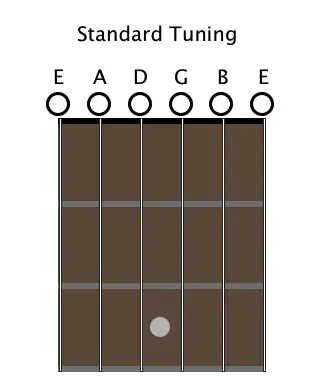How to Tune Your Guitar + Alternate Tunings Explained

2025-04-17
Tuning your guitar is the first step in sounding great. Whether you're a total beginner or a seasoned player experimenting with alternate tunings, having a strong understanding of how your guitar is tuned—and why—will help you play more confidently, creatively, and in tune with others.
Standard Tuning: EADGBE
The most common tuning for a 6-string guitar is E-A-D-G-B-E, from the lowest (thickest) string to the highest (thinnest). This tuning is the foundation for most songs, chords, and scales. Here's a diagram of the guitar neck in standard tuning up to the 12th fret:

Open Strings in Standard Tuning:
- 6th string – E (low)
- 5th string – A
- 4th string – D
- 3rd string – G
- 2nd string – B
- 1st string – E (high)
You can tune your guitar using a clip-on tuner, a smartphone app, or by ear. For a deeper dive into developing your ear, check out How to Train Your Ear for Guitar.
How to Tune Your Guitar
Here’s a quick step-by-step to tune in standard:
- Start with your tuner turned on and set to 440Hz (standard pitch).
- Pluck the string softly with your pick or finger.
- Watch the tuner and adjust the tuning peg until it reads the correct note.
- Always tune UP to pitch (tighten the string) rather than down for better tuning stability.
- Once all strings are in tune, play a few chords to double check.
Getting used to tuning your guitar regularly will help train your ear and prevent your instrument from sounding muddy or off-key.
Alternate Tunings (and Why You Should Try Them)
Alternate tunings give your guitar a completely different voice and open up new musical possibilities. Many famous rock, blues, and metal songs rely on these tunings. Below are two beginner-friendly alternates to explore.
1. Drop D Tuning (DADGBE)
This is one of the simplest alternate tunings. You only change the 6th string:
- 6th string: Drop from E down to D
This makes power chords easier and heavier sounding—perfect for rock riffs. You can use one finger to barre the lowest three strings for a full, punchy chord. Learn more about Drop D tuning here.
2. Half-Step Down (Eb Ab Db Gb Bb Eb)
Also known as Eb tuning, this lowers every string by one semitone. It’s commonly used by artists like Jimi Hendrix, Guns N’ Roses, and Stevie Ray Vaughan. It makes bends easier and gives a slightly darker tone.
- 6th string: E → Eb
- 5th string: A → Ab
- 4th string: D → Db
- 3rd string: G → Gb
- 2nd string: B → Bb
- 1st string: E → Eb
It’s a great tuning to explore expressive blues and rock playing. If you’re working on bends or fast riffs, tuning down a half step can take some pressure off your fingers.
Tips for Alternate Tuning
- Use a digital tuner that shows the exact note and cents off-pitch.
- Play chords and scales after retuning to hear how things shift.
- Consider lighter strings if you plan to play in lower tunings often.
Keep Your Guitar in Tune Longer
Here’s how to prevent tuning drift:
- Stretch your strings after installing new ones.
- Use a proper winding technique when restringing.
- Keep your guitar away from extreme heat or humidity changes.
- Clean your strings after each session to reduce grime and slippage.
What’s Next?
Tuning is just the beginning. Once you're in tune, you can focus on playing better and exploring new sounds. If you're a beginner looking to build strong habits, check out our 30-Minute Practice Routine or browse some of the Top 10 Easy Songs We Teach.
Ready to take your tuning and playing to the next level? Book a private lesson with us in Parkland or one of our nearby locations to get 1-on-1 guidance tailored to your goals.